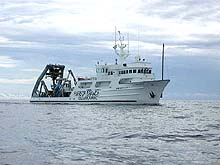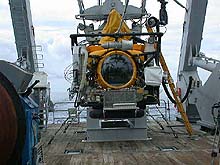Exploring the Reef Systems of Savannah Scarp
September 6, 2001
Reed Bohne
Manager
Gray’s Reef National Marine Sanctuary
"For the sea lies all about us. The commerce of all lands must cross it. The very winds that move over the lands have been cradled on its broad expanse and seek ever to return to it. The continents themselves dissolve and pass to the sea, in grain after grain of eroded land. So the rains that rose from it return again in rivers. In its mysterious past it encompasses all the dim origins of life and receives in the end, after, it may be, many transmutations of dead husks of that same life. For all at last return to the sea –- to Oceanus, the river ocean, like the ever flowing stream of time, the beginning and the end."
Rachel Carson, The Sea Around Us

The Seward Johnson II research vessel moves northward from Ft. Pierce, FL, to begin research at the Savannah Scarp off the coast of Georgia. Click image for larger view.

The Clelia submersible, aboard the Seward Johnson II, awaits deployment into unexplored reef systems. The first dive of the Savannah Scarp leg will begin at 8 am on the morning of Sept. 7. Click image for larger view.
We suspect that many of the reef fish species we encounter at Gray’s Reef spend a part of their life cycle at deeper reef habitats such as the Savannah Scarp, and we are intent on developing a better understanding of the relationship between near-shore and offshore reefs in this part of the country. The value of the deeper reefs as habitat for valuable snapper and grouper fish species is well documented. Given the depleted condition of many of these deep-water species, NOAA and the South Atlantic Fishery Management Council are considering the reefs we will explore for possible designation as a marine protected area.
There is excitement in being the first people to visit these dramatic reefs. Some 20,000 yrs ago, during the last great ice age, this area was the shoreline of the sea. So, as Rachel Carson suggests, the continent has dissolved and returned to the sea. We will explore with great hopes of discovery as we join this leg of the Sustainable Seas Expeditions/Islands in the Stream mission in the South Atlantic Bight.
Sign up for the Ocean Explorer E-mail Update List.











































